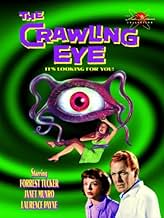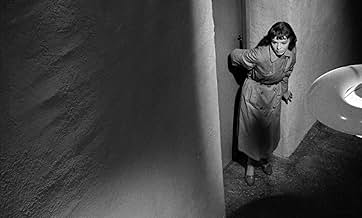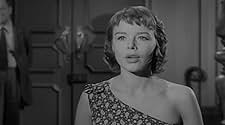NOTE IMDb
5,2/10
5,3 k
MA NOTE
Ajouter une intrigue dans votre langueA series of decapitations on a Swiss mountainside appear to be connected to a mysterious radioactive cloud.A series of decapitations on a Swiss mountainside appear to be connected to a mysterious radioactive cloud.A series of decapitations on a Swiss mountainside appear to be connected to a mysterious radioactive cloud.
- Réalisation
- Scénario
- Casting principal
Avis à la une
A series of decapitations on a Swiss mountainside appear to be connected to a mysterious radioactive cloud, not unlike one that appeared in the Andes years earlier.
Although one of the earliest films to be lampooned on "Mystery Science Theater 3000", there is no denying the growing reputation this movie has received over the years: not only was it referenced in Stephen King's "It", but was also the primary influence behind John Carpenter's minimalist masterpiece "The Fog" (which itself has gone on to influence others).
"Crawling Eye" was the debut feature for director Quentin Lawrence, and probably remains his best-known work. Writer Jimmy Sangster (adapting the work of Peter Key) had only been working a few years, but was a rising star with such Hammer classics as "Dracula" and "Curse of Frankenstein" under his belt. Here he crafts a tale of science gone wrong mixed with the living dead, and done to perfection.
Most interestingly, shortly before the film was released, Lawrence directed a 6-part television miniseries with Key writing the episodes. Today, no copies are thought to exist, and there is no way to know what changes were made for the big screen, as well as what cuts had to be administered to accommodate the shorter running time.
Leading the cast is Forrest Tucker as United Nations troubleshooter Alan Brooks. Tucker had been in nearly 100 films during the 1940s and 50s, and easily handles his role here as the hero -- part action star, part scientific genius. He is assisted by Warren Mitchell as a caricatured Swiss professor (a portrayal which provides the film's only comic relief).
The standout performance comes from Janet Munro as a semi-psychic young woman who goes into trances when she nears the cloud. One gets the impression that she had a bright career before her, and indeed was given a Golden Globe in 1960. Sadly, she passed unexpectedly at age 38.
Today's audiences might find some of the special effects cheesy. Obviously the crew used miniature sets and plenty of rear projection. But in general, there is no denying the impressive use of fog, the freezing effects and the creepy realism of the titular eye. While other 1950s films were busy using radiation as a plot device for large bugs, this one went in a completely different direction -- possibly the only film of its kind.
Notably, "Crawling Eye" was the final film to be produced by Southall Studios, one of the earliest pioneer film studios in the UK, which had made a steady stream of films since 1924. They went out on a high note, which is always nice.
Although one of the earliest films to be lampooned on "Mystery Science Theater 3000", there is no denying the growing reputation this movie has received over the years: not only was it referenced in Stephen King's "It", but was also the primary influence behind John Carpenter's minimalist masterpiece "The Fog" (which itself has gone on to influence others).
"Crawling Eye" was the debut feature for director Quentin Lawrence, and probably remains his best-known work. Writer Jimmy Sangster (adapting the work of Peter Key) had only been working a few years, but was a rising star with such Hammer classics as "Dracula" and "Curse of Frankenstein" under his belt. Here he crafts a tale of science gone wrong mixed with the living dead, and done to perfection.
Most interestingly, shortly before the film was released, Lawrence directed a 6-part television miniseries with Key writing the episodes. Today, no copies are thought to exist, and there is no way to know what changes were made for the big screen, as well as what cuts had to be administered to accommodate the shorter running time.
Leading the cast is Forrest Tucker as United Nations troubleshooter Alan Brooks. Tucker had been in nearly 100 films during the 1940s and 50s, and easily handles his role here as the hero -- part action star, part scientific genius. He is assisted by Warren Mitchell as a caricatured Swiss professor (a portrayal which provides the film's only comic relief).
The standout performance comes from Janet Munro as a semi-psychic young woman who goes into trances when she nears the cloud. One gets the impression that she had a bright career before her, and indeed was given a Golden Globe in 1960. Sadly, she passed unexpectedly at age 38.
Today's audiences might find some of the special effects cheesy. Obviously the crew used miniature sets and plenty of rear projection. But in general, there is no denying the impressive use of fog, the freezing effects and the creepy realism of the titular eye. While other 1950s films were busy using radiation as a plot device for large bugs, this one went in a completely different direction -- possibly the only film of its kind.
Notably, "Crawling Eye" was the final film to be produced by Southall Studios, one of the earliest pioneer film studios in the UK, which had made a steady stream of films since 1924. They went out on a high note, which is always nice.
When I first saw this movie as a kid, it really scared me. But when I finally got it on tape and saw it uncut . . . those eyes were not nearly as scary as I remembered. Some highlights: In the beginning, on the train, watch Forrest Tucker's newspaper. The plot moves along pretty well, one of the best scenes takes place in a cabin, where an unsuspecting climber suddenly finds himself alone when his friend takes a midnight stroll. As he is talking to Forrest Tucker at the lodge he hears . . . a noise outside! Has his friend returned? Go ahead, stupid, open the door. AHHHH! What is it? The line goes dead. They find him later, but he's lost his head. When we finally we get to see these creatures, one is trying to steal a little girl's ball, along with the little girl. With everyone crowded in the halls of the observatory, our hero and his scientific side-kick decide to bomb their uninvited guests. "Bomb a cloud?" Neat bomb. It leaves the eyes dripping and in need of eye drops. It doesn't hurt the building, even though it was a direct hit on the roof. Oh, and there WAS that hole in the wall made by an eye trying to grab Janet Murno. See this movie. It's a real "eyeful."
Not every monster to come out of the fifties was a guy in a rubber suit or a double exposed giant something-or-other. This effective British thriller offers one of the most original monsters ever. The creatures are aliens looking to colonise our planet but first they have to lower the temperature and eliminate one small obstacle . . .us! The cyclopean, tentacled terrors are prone to tearing off the heads of their victims but they possess the technology to kill certain Earth people and bring them back from the dead to do their bidding. Interestingly, the creatures brain waves are easily intercepted by anyone with even latent psychic abilities. This makes Janet Munro our required damsel-in-distress from not only the monsters but from the man (Andrew Faulds) they reanimate to get rid of her. Luckily this movie has two heroes, rough hewn Forrest Tucker (to make the movie appealing to American audiences) and British Lawrence Payne (later to star in Hammer's VAMPIRE CIRCUS). Okay I have a question. Midway through the film we see 2 mountain climbers, Brett and Dewhurst, halfway up the mountain where the aliens are. They take shelter in a small cabin. During the night Brett hears the aliens telepathic call and wanders up the mountain alone. Later Dewhurst gets up to look for him and (I guess) sees one of the aliens coming toward the cabin. He quickly bolts the door but then turns around and screams. Later a search party has to break down the front door and they find Dewhurst dead with his head torn off. WHAT THE HECK GOT HIM? The cabin is intact, not even a window broken, so how in the world did the alien monster kill him? And how does Dewhurst's head get inside the knapsack of Brett who is miles away? No, it isn't Brett who kills him because he could not have gotten into the cabin either. It is indeed a scary moment but very implausible if you stop to think about it. The rest of the movie is very good and quite memorable. Way back in 1957 it played on a double bill with THE STRANGE WORLD OF PLANET X (a/k/a COSMIC MONSTERS) in America. That was a bit before my time and now I am kind of sorry I missed the era of the drive-in. Thank goodness for home video.
When I was very young, I viewed Quentin Lawrence's "The Trollenberg Terror" and Irving Pichel's "The Most Dangerous Game" quite often on late night TV. In retrospect, they are very hokey, but at such an impressionable age, these two films scared my sister and me a great deal. In fact, I think they marked us for life.
"The Trollenberg Terror," more often referred to as "The Crawling Eye" -- I love that name -- is about two psychic sisters in a remote ski resort who are terrorized by a giant, tentacled eye which uses the fog to hide its movements. The film climaxes with a King Kong-like finale involving the United Nations and an aerial battle with phosphorous bombs.
What more could you ask for in a cinematic experience? :) ... Except perhaps some better special effects. :p
"The Trollenberg Terror," more often referred to as "The Crawling Eye" -- I love that name -- is about two psychic sisters in a remote ski resort who are terrorized by a giant, tentacled eye which uses the fog to hide its movements. The film climaxes with a King Kong-like finale involving the United Nations and an aerial battle with phosphorous bombs.
What more could you ask for in a cinematic experience? :) ... Except perhaps some better special effects. :p
A mysterious radioactive cloud hovers on the side of the Trollenberg mountain but no cloud should be at that altitude. In an observatory atop the mountain scientists monitor the behavior of the cloud. Forrest Tucker, who has seen such a cloud before, arrives to investigate. When townspeople start disappearing the cloud appears suspect.
This movie isn't that bad but the monster creatures are so poorly done, they are truly cheesy and the ending reminds me of when I was a boy and used to light plastic army men on fire in the backyard and watch them melt. Just film that and you have the special effects for this film.
The opening scene certainly grabs your attention. There is some nice photography of the Swiss Alps. The acting is fine. Janet Munro is an eye full as the extremely cute psychic who gets manipulated by the monsters.
Crawling Eyes/Trollenberg Terror is a British horror film of the 50's like Day of the Triffids and the Quatermass films.
This movie isn't that bad but the monster creatures are so poorly done, they are truly cheesy and the ending reminds me of when I was a boy and used to light plastic army men on fire in the backyard and watch them melt. Just film that and you have the special effects for this film.
The opening scene certainly grabs your attention. There is some nice photography of the Swiss Alps. The acting is fine. Janet Munro is an eye full as the extremely cute psychic who gets manipulated by the monsters.
Crawling Eyes/Trollenberg Terror is a British horror film of the 50's like Day of the Triffids and the Quatermass films.
Le saviez-vous
- AnecdotesJohn Carpenter has said that this film, with its creatures hidden in the clouds, was partly the inspiration for his film Fog (1980).
- GaffesAfter Brett gashes his forehead in a fight, they discover he does not bleed and that he is already dead. Yet Professor Crevette gives Brett an inject-able sedative in the arm. No blood means there is no way for the drug to travel to his brain.
- Citations
Sarah Pilgrim: *Was* there an accident, Mister Klein?
Mayor Klein: O-On a mountain, uh, dese things sometimes happen.
- Crédits fousThe film's opening credits flash onto the screen when the passenger train rolls into the darkness of a tunnel.
- ConnexionsEdited into FrightMare Theater: The Crawling Eye (2017)
Meilleurs choix
Connectez-vous pour évaluer et suivre la liste de favoris afin de recevoir des recommandations personnalisées
- How long is The Crawling Eye?Alimenté par Alexa
Détails
- Date de sortie
- Pays d’origine
- Langues
- Aussi connu sous le nom de
- The Crawling Eye
- Lieux de tournage
- Alliance Film Studios, St Margarets, Twickenham, Middlesex, Angleterre, Royaume-Uni(studio: made at Alliance Film Studios Ltd)
- Société de production
- Voir plus de crédits d'entreprise sur IMDbPro
- Durée
- 1h 24min(84 min)
- Couleur
- Rapport de forme
- 1.66 : 1
Contribuer à cette page
Suggérer une modification ou ajouter du contenu manquant




























